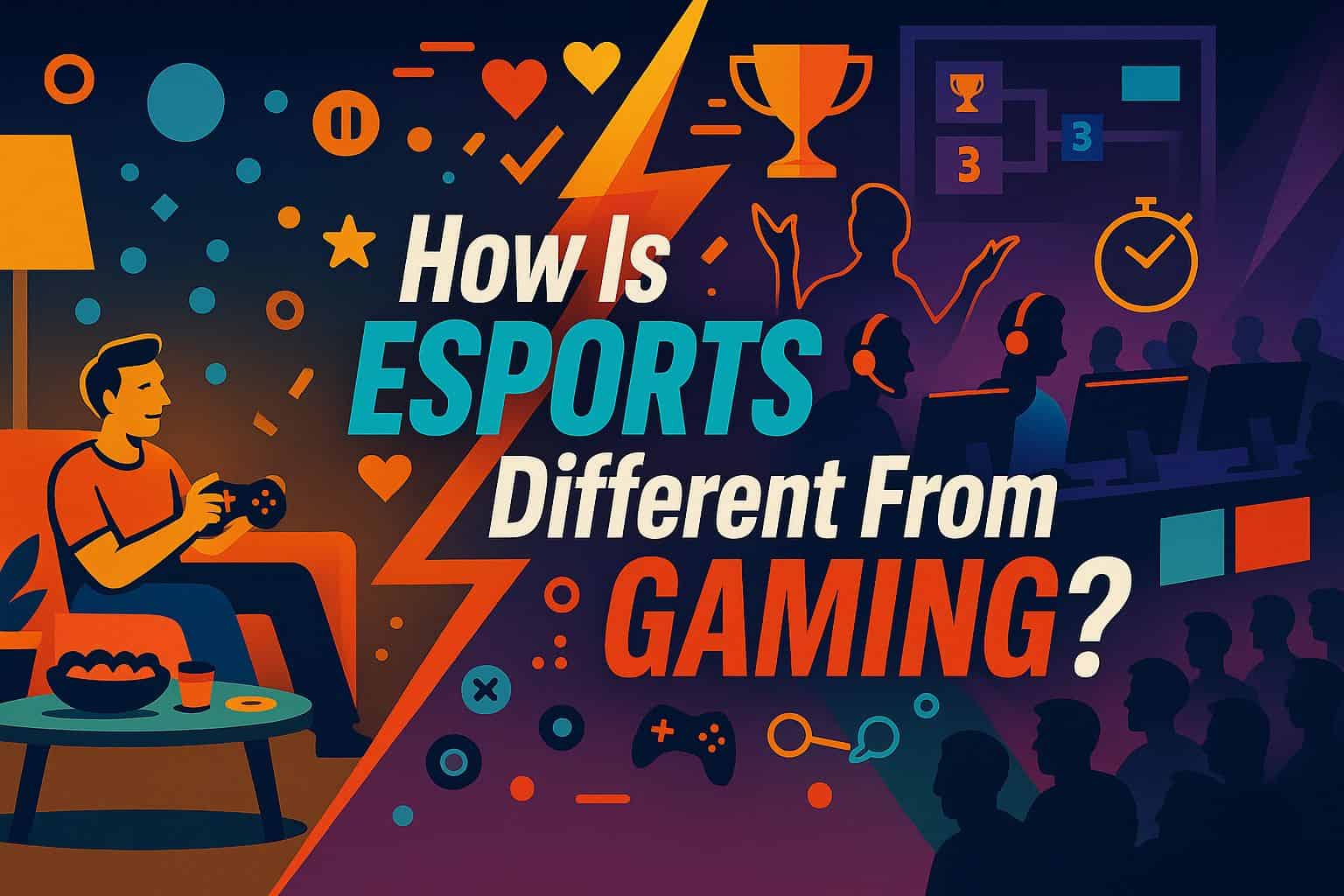Ever wondered how esports is different from gaming? You’re not alone.
The global esports industry is a massive, billion-dollar world, but it’s easy to mix it up with the casual video games we play to unwind.
I’m here to give you seven clear answers that will help you tell the difference between competitive gaming, those intense electronic sports, and just kicking back for a session on your home console.
So, let’s get into it together, and I’ll show you what separates the pros from the players.
Key Takeaways
Esports is all about organized, professional competitions, complete with teams, sponsors, and massive prize pools, while gaming is typically about playing for fun.
The financial stakes are huge in esports, with tournaments like the upcoming Esports World Cup in 2024 boasting a prize pool of over $60 million. Major events draw millions of online viewers.
Esports athletes train like traditional pros with strict schedules, coaches and analysts. We’re talking about legendary teams like Team Liquid and iconic players like Johan “N0tail” Sundstein.
Both casual gamers and esports pros rely on popular platforms like Twitch, Discord, and YouTube Gaming to build communities, stream gameplay, or organize matches.
The global esports market is growing fast, with some analysts predicting it could reach nearly $8.28 billion by 2032, fueled by big-name sponsors like Red Bull and even luxury brands like Louis Vuitton.
Table of Contents
What Is Gaming?

Gaming pulls millions of us into the worlds of computer games, console gaming, and even the classics like the Atari 2600 or Pac-Man. Whether you’re battling it out in Street Fighter, building a blocky paradise in Minecraft, or chasing high scores in Super Mario Bros, you’re part of this huge digital playground.
What does gaming mean and why do people play?
At its heart, gaming just means playing computer games or console games for the pure joy of it. People boot up their PCs or grab a controller to dive into everything from Super Mario Bros. to Minecraft.
For a lot of us, it’s about exploring vast open worlds, taking down a tough boss, or just building something cool in a sandbox game. I know for me, it’s the perfect way to relax after a long day.
Many gamers play to have fun or escape the stress of daily life. Some love the friendly competition in multiplayer online matches, while others use it to connect with friends across the globe in games like Fortnite or League of Legends.
We build huge online communities, create custom mods, and follow our favorite Twitch streamers. Of course, some take that competitive spark a bit further and place bets on esports competitions using online sports betting sites on SportyTrader.
Games give you a pause from reality, challenge your mind, and sometimes, connect you with people you’d never meet otherwise.
What are common types and examples of gaming?
Gaming is a huge universe with tons of different playstyles, stories, and technologies. Players jump into all sorts of genres and devices every single day.
- Single-player games are perfect for solo adventures and deep stories. Think of getting lost for hours in titles like The Legend of Zelda.
- Multiplayer computer games let you team up with friends for shared goals. Minecraft is a classic example, where you can build and survive together.
- First-person shooter games (FPS) are all about fast action and sharp aim. Huge names like Valve Corporation’s Counter-Strike and Blizzard’s Overwatch keep the adrenaline pumping.
- Multiplayer online battle arenas (MOBAs) are the ultimate test of teamwork and strategy. League of Legends by Riot Games and Dota 2 have millions of players and massive esports leagues.
- Battle royales drop a hundred players onto a map for a last-one-standing fight. Fortnite and Apex Legends blew up because of their quick, intense matches.
- Fighting game fans love the head-to-head duels in games like Super Smash Bros. Ultimate and Brawlhalla, which are staples at events like the Evolution Championship Series.
- Mobile gaming offers quick, accessible fun. Games like Candy Crush Saga are perfect examples of casual gaming you can do anywhere.
- Retro classics from the Atari Video Computer System era are still loved by geeks who appreciate pixel art and old-school controls.
What Is Esports?

Esports is where it gets serious. It’s all about pro players, coaches, and teams battling in high-stakes video game competitions. Think of powerhouse organizations like Team Liquid or the entire fighting game community facing off for huge prizes. Tournaments like the League of Legends World Championship and Dota 2 sell out stadiums and get millions of viewers, just like a traditional sport.
What defines esports and its main goals?
Esports, or electronic sports, is defined by organized video game competitions. Events like the League of Legends World Championship or Dota 2’s The International are miles away from casual gaming because they focus on skillful play, deep strategy, and intense teamwork. The goal isn’t just to play, it’s to win under immense pressure in front of a massive audience.
To keep things fair, organizations like the Esports Integrity Commission (ESIC) work to prevent cheating, match-fixing, and other shady behavior that could harm the sport.
https://www.youtube.com/watch?v=YomJQm_OLec
Major brands have poured millions into the esports market, with revenue projections for 2024 expected to hit $2.4 billion. This ecosystem rewards excellence and is all about one thing, pure competition.
How is esports organized and what are some examples?
Esports has a clear structure designed to create nonstop action for fans and a competitive ladder for players. It’s a highly organized machine.
- Leagues and Tournaments: These are the backbone of esports. Organizers like the ESL FACEIT Group run massive global circuits. Games like Overwatch 2 have full seasons in competitions like the OWCS, while Dota 2 has its legendary annual championship, The International.
- Professional Teams: Esports teams function just like traditional sports teams. They have daily training schedules, and they hire coaches, managers, and analysts to review gameplay and scout opponents.
- Major Publishers: Companies like Nintendo and Riot Games run their own esports events. Riot’s Valorant Champions Tour (VCT), for example, is a global circuit that highlights incredible team-based tactics.
- Streaming Platforms: Events are broadcast live on platforms like Twitch and YouTube Gaming. I remember watching the OWCS finals once, and the Twitch chat was flying by so fast you couldn’t even read it.
- Sponsorships: The ecosystem runs on sponsors. Teams get deals with everyone from Red Bull to luxury brands like Louis Vuitton.
- Support Staff: It takes an army to run an esports organization. Casters and commentators break down the action, analysts predict outcomes, and social media managers make sure the biggest moments go viral.
- Player Wellness: Top teams now hire sports psychologists to help athletes manage the intense pressure of competing in front of millions.
Want to learn more about how it all works? You can dive deeper into the esports basics & structure.
Key Differences Between Gaming and Esports

Anyone can pick up a controller and start gaming, but becoming an esports pro requires a whole different level of skill and discipline. Players in games like Dota 2 train with coaches and analysts to compete in huge tournaments for life-changing money.
How does casual gaming differ from competitive play?
Think of casual gaming as a weekend hobby. The focus is on having fun, exploring a story, or maybe beating your personal high score in games like Animal Crossing or Candy Crush. The vibe is relaxed, with no real pressure or strict schedules.
Competitive play in esports is a full-time job. Players join structured teams and practice for nearly 8 hours a day, 6 days a week. Their training includes solo drills, team scrimmages, and reviewing past games to analyze mistakes. They’re aiming for pro leagues, packed stadiums, and massive prize pools.
As Dota 2 champion Johan “N0tail” Sundstein once said, “Success in esports is ninety percent practice and ten percent talent.”
The line is clear, organized competition, big sponsors, and huge rewards are what set esports apart.
What professional structures exist within esports?
The esports world is built on official competition formats like leagues and tournaments. Major events are run by large organizations like ESL and Riot Games, which enforce strict rules for fair play.
Esports teams are structured like traditional sports clubs. They give players contracts, salaries, and access to top-tier training facilities. A whole support staff, including team managers, coaches, and analysts, works behind the scenes to break down gameplay and develop strategies.
The ecosystem has also expanded into education. Many universities now have varsity esports programs and even offer scholarships. The University of California, Irvine (UCI), for example, was one of the first public universities to create an official esports program and offers scholarships of up to $6,000.
What financial benefits and sponsorships are involved in esports?
Big brands like Red Bull, Coca-Cola, and even Mercedes-Benz love sponsoring esports tournaments because the events draw millions of dedicated fans. The inaugural Esports World Cup, scheduled for summer 2024, announced an unprecedented prize pool of over $60 million, the largest in esports history.
The money flows in from multiple sources.
- Sponsorships: Teams and leagues get cash from brands wanting to reach the gaming audience.
- Media Rights: Streaming platforms like Twitch and YouTube pay for the rights to broadcast matches.
- Ticket Sales: Live events can sell out huge arenas, just like a major concert or sporting event.
- Merchandise: Fans buy jerseys, hats, and other gear to support their favorite teams.
This massive financial investment is a key reason the industry continues to grow at such a rapid pace.
Overlapping Aspects of Gaming and Esports

Even though they’re different, gaming and esports share a lot of common ground. Both worlds use tools like Discord and Twitch to connect, and online communities are where friendships are built through group chats and shared streams.
What technology and platforms are shared by gaming and esports?
At the end of the day, both casual and pro players rely on the same core technology. Streaming platforms like Twitch and YouTube Gaming are where communities for both worlds collide. I’ve spent countless hours on Twitch watching both laid-back streams and intense tournament finals.
The hardware is also the same. High-end PCs, consoles, and high-speed internet are crucial for any serious gamer. Both groups depend on powerful graphics cards from companies like NVIDIA and responsive peripherals from brands like Logitech.
Everyone also uses the same social platforms, like Discord and X (formerly Twitter), to find teammates, talk strategy, or just cheer on their favorite players.
The tech that entertains you in your basement also packs stadiums for esports finals.
How do community and social interaction overlap in both?
Both casual gamers and esports fans gather in the same digital hangouts. Discord servers, Reddit communities like r/gaming, and Twitch chats are constantly buzzing with memes, match analysis, and friendly advice.
Gamers will swap building tips for Minecraft, while esports fans rally around a stream to cheer for their favorite Overwatch League team. These communities are where the passion for gaming lives, regardless of skill level.
Major events like The International or EVO become global celebrations, with fans hosting watch parties in their living rooms. It’s all about a shared love for the game. The lines get even blurrier when you see how many women are a huge part of this scene, which you can learn more about in this piece on women in esports.
The Rise of Esports
Esports isn’t new, but its growth has exploded. Major tournaments now pack stadiums and dominate streaming platforms like Twitch. Games like League of Legends and CS2 offer huge prize pools, turning pro gaming into a true global spectacle.
How have professional esports tournaments grown recently?
Professional esports tournaments have become massive global events, attracting huge viewership and serious investment. The League of Legends World Championship 2024 final, for example, became the most-watched esports event in history with a peak of 6.94 million viewers outside of China. When you include Chinese viewership, that number jumps to a staggering 50 million.
For comparison, the 2024 NBA Finals peaked at around 12.3 million viewers in the US. While the Super Bowl is still king in the States, the global reach of esports is undeniable.
This growth is also happening at the collegiate level. High schools and colleges now have their own varsity esports teams. Even major sports leagues are getting involved, like with the NBA 2K League, which ties pro basketball directly to digital competition.
What are some of the most popular esports games today?
A few key games dominate the esports landscape, drawing in the biggest crowds and the largest prize pools. These are the titles that define modern competitive gaming.
- League of Legends (LoL): Developed by Riot Games, LoL is a titan in the esports world. Its annual World Championship is consistently one of the most-watched esports events of the year.
- Counter-Strike 2 (CS2): The latest installment in the legendary FPS series from Valve Corporation, CS2 is a pillar of competitive gaming, with a massive following for tournaments like the PGL Major.
- Dota 2: Famous for its incredible complexity and massive prize pools. For years, its championship tournament, The International, has set records, with the 2021 event offering a prize pool of over $40 million.
- Valorant: Another hit from Riot Games, this tactical shooter combines sharp gunplay with unique character abilities, and its Valorant Champions Tour has quickly become a fan favorite.
- Fortnite: While known for its casual fun, Fortnite’s competitive scene is massive, with the Fortnite World Cup offering life-changing prize money.
How Will Gaming and Esports Change in 2025?
The future looks bright for both gaming and esports. The global esports market is projected to continue its explosive growth, with some forecasts predicting it could reach $8.28 billion by 2032.
This growth is fueled by things like esports betting and dedicated fan communities. We’re also seeing a rise in new college degrees focused on competitive gaming, opening up career paths in broadcasting, coaching, and event management.
You can also expect to see new technologies change the viewing experience. Look for more immersive VR applications that could one day let you feel like you’re sitting right beside your favorite player during a match.
As streaming platforms like Twitch continue to grow, the line between casual gaming and professional sports entertainment will keep blurring. Both worlds are gaining more fans, and more money, at an incredible speed.
People Also Ask
What is the main difference between esports and gaming?
Esports is organized, competitive gaming for an audience, often with cash prizes on the line in tournaments for games like League of Legends, while gaming is the broader hobby of playing any video game for fun.
Can anyone join esports, or do you need special skills?
Professional esports players often train 8 to 10 hours a day, similar to traditional athletes, using aim trainers like KovaaK’s and analyzing gameplay to master skills like map awareness and reaction time.
Are all video games part of esports?
No, only games built for balanced, skill-based competition, like Valorant or Street Fighter 6, become major esports, while story-driven or casual games like Stardew Valley typically do not.
Why do people say esports is like traditional sports?
Both feature professional leagues like the Call of Duty League, massive live events with millions of viewers, and big-name sponsors such as Red Bull and Intel.
